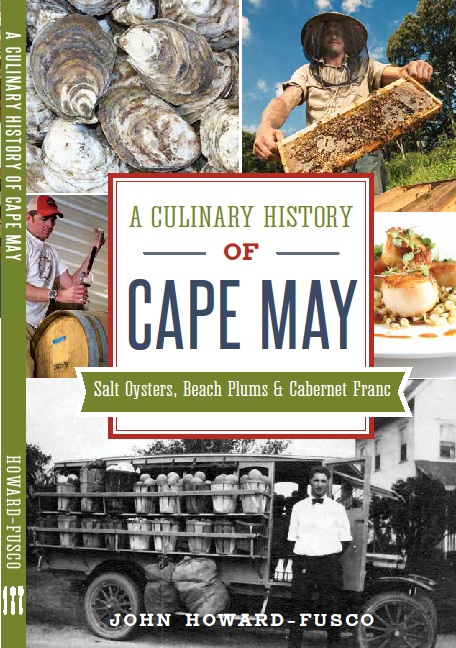
So I wrote this book…
It was that email in July 2013. Never in the history of me has so much work and effort been pursued, and it was over an email.
And thank God for that email.
The aforementioned electronic correspondence came from The History Press, looking for local authors to write about South Jersey food history. Instead they found a ham-n-egger who had pounded his keyboard enough times to make the occasional passable piece of writing. The good news is that they connected with a writer who had two things going for him: a burning desire to delve into the history of food in South Jersey and not an ounce of sense in his noggin.
And so, a nearly three-year journey came to an end in Spring 2016 when it was time to hand in the manuscript of a book entitled A Culinary History of Cape May: Salt Oysters, Beach Plums & Cabernet Franc. As the old saying goes, the work taught me how to do the work. Eventually. Along the way, I found countless ways of how not to write a book. That was, erm, enlightening. There are still a few scars healing over a certain flash drive that went kaplooey – with several pages of notes that would never see the light of a computer screen again. Acceptance, acceptance, acceptance…
But it was not all an endless veil of tears. Nay! I got to have an impromptu pumpkin picking session with Leslie Rea on his farm. I was given the privilege of leafing through court documents dating back more than two centuries. I discovered people in my research that made me want to go back in time to meet them, sipping a julep by the seaside while they told me their tales. What would it have been like to gaze in awe at the Mount Vernon Hotel and its massive dining room, or dine at the opening of Hotel Cape May…
“You must have had a lot of great meals while you made the book.”
I get this comment a lot. Here is my short response to this: not really. Here’s the expanded response: I spent most of my time at the Cape May County Library, the county clerk’s office, and the library at the Historical Museum. I did manage some meals and take a number of pictures for the book, but did not eat my way up and down Cape May. It’s not a restaurant guide – it’s a history book.
“So what’s so interesting about Cape May’s food history?”
Well, I wrote a whole book about, didn’t I? What kind of question is that?
There’s an interesting dichotomy about Cape May. While the overriding narrative have been about the creation of the first great American seaside resort, the large hotels, and the modern embrace of its history, there’s also the story of the famers and fisherman that sustained the community for the nine or ten months a year when the visitors were not jamming up the beaches. Thankfully, Cape May has in recent years begun to embrace this part as well. A good chunk of the book I have written makes an attempt to touch upon both sides.
“When will the book be available?”
Now! Nownownow NOW!
It’s available now. You can go to Amazon and purchase it here.
If you happen to be in the Cape May area, you can currently buy the book at these locations:
Whale’s Tale – 312 Washington Street, Cape May.
Cape Atlantic Book Company – 421 Washington Street (2nd Floor), Cape May.
Celebrate Cape May – 315 Ocean Street (Unit 21), Cape May.
Dellas 5 and 10 – 501-503 Washington Street, Cape May.
Sunset Beach Gifts – 502 Sunset Boulevard, Cape May Point.
Hawk Haven Vineyard and Winery – 600 S. Railroad Avenue, Rio Grande.
Stephen Reses Pharmacy – 269 W. White Horse Pike (corner of Route 575) – Pomona.
Ocean City Historical Museum – 1735 Simpson Avenue, Ocean City.
Sun Rose Words and Music – 756 Asbury Avenue, Ocean City.